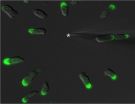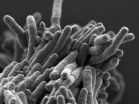An improved age for Earth's latest magnetic field reversal using radiometric dating
2015-07-07
(Press-News.org) This news release is available in Japanese.
The Earth's magnetic field periodically reverses such that the north magnetic pole becomes the south magnetic pole. The latest reversal is called by geologists the Matuyama-Brunhes boundary (MBB), and occurred approximately 780,000 years ago. The MBB is extremely important for calibrating the ages of rocks and the timing of events that occurred in the geological past; however, the exact age of this event has been imprecise because of uncertainties in the dating methods that have been used.
A team of researchers based in Japan and Canada have obtained an improved age for the MBB. The team studied volcanic ash that was deposited immediately before the MBB. This volcanic ash contains small crystals called zircons. Some of these crystals formed at the same time as the ash; thus, radiometric dating of these zircons using the uranium-lead method provided the exact age of the ash. To verify their findings, the researchers also used a different method to date sedimentary rock from the same place that was formed at the time of the MBB. The combined results demonstrate that the age of the MBB is 770.2 ± 7.3 thousand years ago. The research has been published in the journal Geology.
Dr. Yusuke Suganuma of the National Institute of Polar Research, Tokyo, who is the lead author on the paper, commented: "This study is the first direct comparison of radiometric dating, dating of sediments, and the geomagnetic reversal for the Matuyama-Brunhes boundary. Our work contributes calibrating the geological time scale, and will be extremely important in future studies of the events that occurred at this time."
INFORMATION:
Source: National Institute of Polar Research (NIPR), Ibaraki University, JAMSTEC
[Attachments] See images for this press release:

ELSE PRESS RELEASES FROM THIS DATE:
2015-07-07
July 6, 2015, Shenzhen, China-- Mitochondrial genome (mitogenome) database demonstrated its great value on detecting wild bees in UK farms via mitochondrial metagenomics pipeline, a new approach developed by scientists from the China National Genebank (CNGB), BGI-Shenzhen.
The study published today in the journal Methods in Ecology and Evolution shows that, with mitogenome references, collecting wild bees, extracting their mixed DNA, and directly reading the DNA of the resultant 'bee soup' could finally make large-scale bee monitoring programmes feasible. This new research ...
2015-07-07
Chicago (July 7, 2015)- Switzerland has a long history of trying to be as self-sufficient and energy independent as possible. Although its energy supply system has served it well in the past, the country is now looking to turn away from its reliance on nuclear power and seeks to compensate for the energy lost from hydropower as a result of climate change. In the latest issue of the Bulletin of the Atomic Scientists, published by SAGE, Dominic Notter of Empa discusses how the country aims to address this transition, finding a new supply mix that combines energy conservation, ...
2015-07-07
Scientists at the University of California, Davis, have identified a key mechanism in neuropathic pain. The discovery could eventually benefit millions of patients with chronic pain from trauma, diabetes, shingles, multiple sclerosis or other conditions that cause nerve damage.
A biological process called endoplasmic reticulum stress, or ER stress, is the significant driver of neuropathic pain, said lead researchers Bora Inceoglu of the UC Davis Department of Entomology and Nematology and UC Davis Comprehensive Cancer Center, and Ahmed Bettaieb, Department of Nutrition. ...
2015-07-07
LOS ANGELES (July 6, 2015) - Cedars-Sinai researchers have successfully tested two new methods for preserving cognition in laboratory mice that exhibit features of Alzheimer's disease by using white blood cells from bone marrow and a drug for multiple sclerosis to control immune response in the brain.
Under the two approaches, immune cells from outside the brain were found to travel in greater numbers through the blood into the brain. The study showed measurable benefits in mice, an encouraging step toward further testing of these potentially powerful strategies in human ...
2015-07-07
New research suggests guidelines on children's exposure to radio frequency waves from technology are confusing for parents.
The review into the polices of 34 countries, carried out by Dr Mary Redmayne, from the Department of Epidemiology and Preventive Medicine at Monash University, found varying degrees of advice about children's exposure to radio frequency electromagnetic fields (RF-EMF).
RF-EMFs are emitted from technology including WiFi, tablets and mobile phones. Associated with an increased risk of some brain tumours in heavy and long-term phone users, RF-EMFs ...
2015-07-07
ARLINGTON HEIGHTS, Ill. (July 7, 2015) - Parents of kids with severe allergies know how scary a severe allergic reaction (anaphylaxis) is. New research offers clues as to why some kids can have a second, related reaction hours later - and what to do about it.
A study in the Annals of Allergy, Asthma and Immunology, the scientific publication of the American College of Allergy, Asthma and Immunology (ACAAI), examined records of 484 children seen in an emergency department (ED) for anaphylaxis. The researchers tracked whether there was a second, follow-up reaction. Delayed ...
2015-07-07
When Greek mythology and cell biology meet, you get the protein Callipygian, recently discovered and named by researchers at The Johns Hopkins University for its role in determining which area of a cell becomes the back as it begins to move.
The findings, made in the amoeba Dictyostelium discoideum, shed light on how symmetrical, round cells become "polarized," or asymmetrical and directional. A summary of the findings was published online June 30 in the Proceedings of the National Academy of Sciences.
"Cells have to have a front and a back to migrate," says Peter ...
2015-07-07
Scientists have discovered new ways in which the malaria parasite survives in the blood stream of its victims, a discovery that could pave the way to new treatments for the disease.
The researchers at the Medical Research Council's (MRC) Toxicology Unit based at the University of Leicester and the London School of Hygiene & Tropical Medicine identified a key protein, called a protein kinase, that if targeted stops the disease. The study is published today (Tuesday) in Nature Communications.
Malaria is caused by a parasite that lives inside an infected mosquito and ...
2015-07-07
Testing thousands of approved drugs, EPFL scientists have identified an unlikely anti-tuberculosis drug: the over-the-counter antacid lansoprazole (Prevacid®).
Tuberculosis continues to be a global pandemic, second only to AIDS as the greatest single-agent killer in the world. In 2013 alone, the TB bug Mycobacterium tuberculosis caused 1.5 million deaths and almost nine million new infections. Resistance to TB drugs is widespread, creating an urgent need for new medicines. EPFL scientists have now identified lansoprazole, a widely used, over-the-counter antacid, as ...
2015-07-07
New research from the University of Copenhagen and Herlev and Gentofte Hospital shows that high vitamin C concentrations in the blood from the intake of fruit and vegetables are associated with a reduced risk of cardiovascular disease and early death.
Fruit and vegetables are healthy. We all know that. And now there is yet another good reason for eating lots of it. New research from the University of Copenhagen shows that the risk of cardiovascular disease and early death falls with a high intake of fruit and vegetables, and that this may be dued to vitamin C.
The ...
LAST 30 PRESS RELEASES:
[Press-News.org] An improved age for Earth's latest magnetic field reversal using radiometric dating


